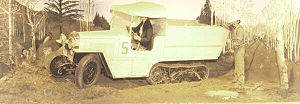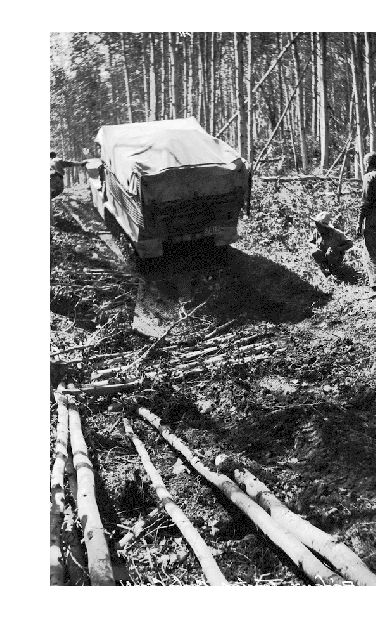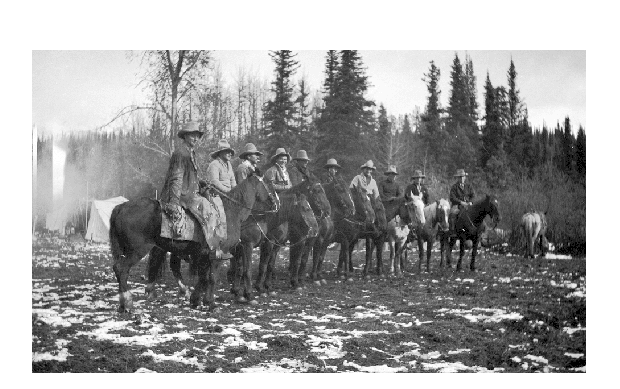
Bedaux Expedition
Encyclopedia

French people
The French are a nation that share a common French culture and speak the French language as a mother tongue. Historically, the French population are descended from peoples of Celtic, Latin and Germanic origin, and are today a mixture of several ethnic groups...
millionaire
Millionaire
A millionaire is an individual whose net worth or wealth is equal to or exceeds one million units of currency. It can also be a person who owns one million units of currency in a bank account or savings account...
, Charles Eugène Bedaux
Charles Bedaux
Charles Eugène Bedaux was one of the most colorful millionaires of the early twentieth century. Friends with British royalty and Nazis alike, he amassed a fortune expanding on the Taylorism style of scientific management and was a big game hunter and explorer.-Early years:Charles Bedaux was born...
to cross the British Columbia
British Columbia
British Columbia is the westernmost of Canada's provinces and is known for its natural beauty, as reflected in its Latin motto, Splendor sine occasu . Its name was chosen by Queen Victoria in 1858...
wilderness, while making a movie, testing Citroën
Citroën
Citroën is a major French automobile manufacturer, part of the PSA Peugeot Citroën group.Founded in 1919 by French industrialist André-Gustave Citroën , Citroën was the first mass-production car company outside the USA and pioneered the modern concept of creating a sales and services network that...
half-tracks and generating publicity for himself. He set off on this unusual and ill-conceived excursion accompanied by more than a hundred people, including his wife, his mistress
Mistress (lover)
A mistress is a long-term female lover and companion who is not married to her partner; the term is used especially when her partner is married. The relationship generally is stable and at least semi-permanent; however, the couple does not live together openly. Also the relationship is usually,...
who was an Italian
Italian people
The Italian people are an ethnic group that share a common Italian culture, ancestry and speak the Italian language as a mother tongue. Within Italy, Italians are defined by citizenship, regardless of ancestry or country of residence , and are distinguished from people...
Countess, and an Academy Award winning film director from Hollywood, Floyd Crosby
Floyd Crosby
Floyd Delafield Crosby, A.S.C. was an American cinematographer.Crosby was born and raised in West Philadelphia, the son of Julia Floyd and Frederick Van Schoonhoven Crosby...
, who would later be praised for his work on High Noon
High Noon
High Noon is a 1952 American Western film directed by Fred Zinnemann and starring Gary Cooper and Grace Kelly. The film tells in real time the story of a town marshal forced to face a gang of killers by himself...
. Also along for the trip were several dozen Alberta cowboys and a large film crew. To map the route of the expedition, the Canadian government sent along two geographers, Frank Swannell
Frank Swannell
Frank Cyril Swannell was one of British Columbia's most famous surveyors.He came to British Columbia during the era of the Klondike Gold Rush and became a surveyor's assistant. Then, from 1908, he was a professional surveyor and surveyed many regions of British Columbia...
and Ernest Lemarque. The expedition started off at Edmonton, Alberta on July 6, 1934 and their goal was to travel 1500 miles (2,414 km) to Telegraph Creek, British Columbia
Telegraph Creek, British Columbia
Telegraph Creek is a small community located off Highway 37 in Northern British Columbia at the confluence of the Stikine River and Telegraph Creek. The only permanent settlement on the Stikine River, it is home to approximately 350 members of the Tahltan First Nation, as well as another 50...
. Much of the trip would have to be made through regions that were relatively uncharted and had no trails.
The route
The AlbertaAlberta
Alberta is a province of Canada. It had an estimated population of 3.7 million in 2010 making it the most populous of Canada's three prairie provinces...
leg of their journey began at Edmonton, to Athabasca
Athabasca, Alberta
Athabasca is a town in northern Alberta, Canada. It lies north of Edmonton on Highway 2, on the banks of the Athabasca River. It is the centre of Athabasca County. Until 1913 it was known as Athabasca Landing.- History :...
, Grande Prairie and then into British Columbia to Dawson Creek, and Fort St. John
Fort St. John, British Columbia
The City of Fort St. John is a city in northeastern British Columbia, Canada. A member municipality of the Peace River Regional District, the city covers an area of about 22 km² with 22,000 residents . Located at Mile 47, it is one of the largest cities along the Alaska Highway. Originally...
. From there the expedition headed north to Montney and then northeast to Halfway River on to Whitewater Post over the Rocky Mountains
Rocky Mountains
The Rocky Mountains are a major mountain range in western North America. The Rocky Mountains stretch more than from the northernmost part of British Columbia, in western Canada, to New Mexico, in the southwestern United States...
. From there, Bedaux had planned for the expedition to cross over the Sifton Pass, to Dease Lake and the Stikine River
Stikine River
The Stikine River is a river, historically also the Stickeen River, approximately 610 km long, in northwestern British Columbia in Canada and southeastern Alaska in the United States...
to Telegraph Creek, and ultimately the Pacific Ocean
Pacific Ocean
The Pacific Ocean is the largest of the Earth's oceanic divisions. It extends from the Arctic in the north to the Southern Ocean in the south, bounded by Asia and Australia in the west, and the Americas in the east.At 165.2 million square kilometres in area, this largest division of the World...
. However, this final leg of the trip was never completed.
Training camp in Jasper
In June 1934, Bedaux assembled the members of the expedition in Jasper, AlbertaJasper, Alberta
Jasper is a specialized municipality in western Alberta, Canada. It is the commercial centre of Jasper National Park, located in the Canadian Rockies in the Athabasca River valley....
, for compulsory fitness training. Bedaux reported to the press that such training was necessary for what was sure to be a long and difficult trip, involving hiking
Hiking
Hiking is an outdoor activity which consists of walking in natural environments, often in mountainous or other scenic terrain. People often hike on hiking trails. It is such a popular activity that there are numerous hiking organizations worldwide. The health benefits of different types of hiking...
, rafting
Rafting
Rafting or white water rafting is a challenging recreational outdoor activity using an inflatable raft to navigate a river or other bodies of water. This is usually done on white water or different degrees of rough water, in order to thrill and excite the raft passengers. The development of this...
and mountain climbing.
However, no training sessions were accomplished as the members of the expedition were kept too busy attending champagne parties and formal dinners that were being held in their honor.
The Citroëns

André Citroën
André-Gustave Citroën was a French industrialist. He is remembered chiefly for the make of car named after him, but also for his application of double helical gears.- Life and career :...
, who designed the Kégresse track equipped half-track
Half-track
A half-track is a civilian or military vehicle with regular wheels on the front for steering, and caterpillar tracks on the back to propel the vehicle and carry most of the load. The purpose of this combination is to produce a vehicle with the cross-country capabilities of a tank and the handling...
trucks that were used on the expedition. Of the five Citroëns that the party used, two slid off of cliffs and a third was used in a shot where it was put on a raft where it was supposed to meet a stick of dynamite
Dynamite
Dynamite is an explosive material based on nitroglycerin, initially using diatomaceous earth , or another absorbent substance such as powdered shells, clay, sawdust, or wood pulp. Dynamites using organic materials such as sawdust are less stable and such use has been generally discontinued...
and explode. However, the shot was ruined when the dynamite failed to explode and the truck floated down river and was stuck in a sandbar. The last two Citroëns were abandoned near Halfway River. When the Alaska Highway
Alaska Highway
The Alaska Highway was constructed during World War II for the purpose of connecting the contiguous U.S. to Alaska through Canada. It begins at the junction with several Canadian highways in Dawson Creek, British Columbia and runs to Delta Junction, Alaska, via Whitehorse, Yukon...
was built in the 40's, a Fort St. John man discovered the remains of these last two half-tracks and one was donated to the Western Development Museum in Moose Jaw, Saskatchewan
Moose Jaw, Saskatchewan
Moose Jaw is a city in south-central Saskatchewan, Canada on the Moose Jaw River. It is situated on the Trans-Canada Highway, west of Regina. Residents of Moose Jaw are known as Moose Javians. It is best known as a retirement and tourist city that serves as a hub to the hundreds of small towns...
.
The journey

Lieutenant governor
A lieutenant governor or lieutenant-governor is a high officer of state, whose precise role and rank vary by jurisdiction, but is often the deputy or lieutenant to or ranking under a governor — a "second-in-command"...
. Just outside of the city, it began to rain. Those dismal weather conditions would accompany the expedition through much of their trip. Despite the weather and poor road conditions, they made good progress and by July 12th they left Grande Prairie and on the 17th were in British Columbia on the trail from Taylor
Taylor, British Columbia
The District of Taylor is a small town in northeastern British Columbia, Canada, located on mile 36 of the Alaska Highway. Taylor, a member municipality of the Peace River Regional District, covers an area of about 17 km² with 1,380 residents. As it is just south of the much larger city of...
to Fort St, John.

By then, Bedaux had come to the decision that the expedition had to become more newsworthy than it already was and he fired his radio operator and announced that the party would continue without a wireless
Wireless
Wireless telecommunications is the transfer of information between two or more points that are not physically connected. Distances can be short, such as a few meters for television remote control, or as far as thousands or even millions of kilometers for deep-space radio communications...
radio. Furthermore, he decided that the Citroëns were expendable and would create a bigger sensation if they were destructed on film rather than simply making the trip intact.
In August, two of the Citroëns were pushed over a 300 feet (91.4 m) cliff near Halfway River and a third was floated downriver for an explosion scene that didn't pan out. Nevertheless, Bedaux's plan worked and Canadian and American newspapers carried the news that three of the cars had been lost and that some of the expedition members had barely escaped death in these terrible "accidents". The party was lauded for its bravery and determination to continue on despite this terrible setback.

Edmonton Journal
The Edmonton Journal is a daily newspaper in Edmonton, Alberta. It is part of the Postmedia Network.-History:The Journal was founded in 1903 by three local businessmen — John Macpherson, Arthur Moore and J.W. Cunningham — as a rival to Alberta's first newspaper, the 23-year-old...
reported that the party was turning back.
The party reached Hudson's Hope after nearly four months in the wilderness and a party was thrown in honor of their near achievement, a party which turned out to be one of the biggest celebrations that the town had ever thrown.
The movie
Crosby's footage disappeared only to be found decades later in a basement in Paris. A documentary, The Champagne Safari, based on this footage, was made in 1995 by filmmaker George Ungar.Places named for Bedaux
- The Bedaux Pass at the head of the Muskwa RiverMuskwa RiverThe Muskwa River flows 257 km through northern British Columbia, Canada. It is a major tributary of the Fort Nelson River - part of the Mackenzie River system. The river rises at Fern Lake in the Bedaux Pass in the Northern Rocky Mountains. From there, it flows generally east, then north,...
, in the Kwadacha Wilderness Provincial ParkKwadacha Wilderness Provincial ParkKwadacha Wilderness Provincial Park is a provincial park in British Columbia, Canada. It is part of the larger Muskwa-Kechika Management Area, which include to the north of the Kwadacha the Northern Rocky Mountains Provincial Park and Stone Mountain Provincial Park....
External links
Further reading
- My Country: The Remarkable Past Pierre BertonPierre BertonPierre Francis de Marigny Berton, was a noted Canadian author of non-fiction, especially Canadiana and Canadian history, and was a well-known television personality and journalist....
ISBN 978-0-385-65928-4 - Romance Of The Alaska Highway Philip Godsell ISBN Unknown
- The Price of Power : A Biography of Charles Eugene Bedaux Jim Christy ISBN 0385189095

